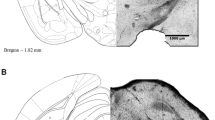Abstract
Rationale
Vasopressin (AVP) plays a role in regulating anxiety, which is thought to be partially mediated through the V1a receptor. Recently, JNJ-17308616 was identified as a V1a antagonist.
Objectives
The purpose of this work was to assess V1a receptor affinity and selectivity of JNJ-17308616 and in vivo efficacy in animal models of anxiety-like behavior.
Materials and methods
The affinity of JNJ-17308616 for the human and rat V1a, V1b, V2, and oxytocin receptors was determined. Central administration of AVP induces a scratching response mediated through the V1a receptor. Inhibition of scratching was used as a behavioral measure of in vivo potency. JNJ-17308616 was tested in five models of anxiety: rat elevated plus-maze (EPM), rat-elevated zero-maze (EZM), rat-conditioned lick suppression (CLS), rat pup separation-induced ultrasonic vocalizations (USV), and mouse marble burying (MMB).
Results
High affinity for the human V1a receptor (K i 5.0 nM) was confirmed. However, the rat V1a receptor affinity was more modest (K i 216 nM), and the compound was not selective over the rat V2 receptor (K i 276 nM). At 100 mg/kg, JNJ-17308616 significantly reduced anxiety-like behavior in EPM, USV, and MMB; at 30 mg/kg, it was effective in EZM and CLS. JNJ-17308616 neither impaired social recognition nor reduced locomotor activity.
Conclusions
These results demonstrate the potential for V1a receptor antagonists as novel anxiolytics. Tool compounds that have greater V1a receptor selectivity than JNJ-17308616 are necessary to make precise conclusions about the role of the V1a receptor in affective disorders.









Similar content being viewed by others
References
Bielsky IF, Hu SB, Szegda KL, Westphal H, Young LJ (2004) Profound impairment in social recognition and reduction in anxiety-like behavior in vasopressin V1a receptor knockout mice. Neuropsychopharmacology 29:483–493
Egashira N, Tanoue A, Higashihara F, Mishima K, Fukue Y, Takano Y, Tsujimoto G, Iwasaki K, Fujiwara M (2004) V1a receptor knockout mice exhibit impairment of spatial memory in an eight-arm radial maze. Neurosci Lett 356:195–198
Egashira N, Tanoue A, Matsuda T, Koushi E, Harada S, Tanako Y, Tsujimoto G, Mishima K, Iwasaki K, Fujiwara M (2007) Impaired social interaction and reduced anxiety-like behavior in vasopressin V1a receptor knockout mice. Behav Brain Res 178:123–127
Everts HG, Koolhaas JM (1999) Differential modulation of lateral septal vasopressin receptor blockade in spatial learning, social recognition, and anxiety-related behaviors in rats. Behav Brain Res 99:7–16
Griebel G, Simiand J, Serradeil-Le Gal C, Wagnon J, Pascal M, Scatton B, Maffrand JP, Soubrie P (2002) Anxiolytic- and antidepressant-like effects of the non-peptide vasopressin V1b receptor antagonist, SSR149415, suggest an innovative approach for the treatment of stress-related disorders. Proc Natl Acad Sci U S A 99:6370–6375
Griebel G, Simiand J, Stemmelin J, Gal CS, Steinberg R (2003) The vasopressin V1b receptor as a therapeutic target in stress-related disorders. Curr Drug Targets CNS Neurol Disord 2:191–200
Gunnet JW, Look R, Vaidya AH, Xiang M, Chen RH, Combs DW, Demarest KT. The characterization of JNJ-17308616: a potent and selective vasopressin-1A (V1a) receptor antagonist. Program No 115.1. 2004 Abstract Viewer/Itinerary Planner. Washington, DC: Society for Neuroscience, 2004. Online
Hodgson RA, Guthrie DG, Pond AJ, Morgan C, Lu X, Mullins D, Miller M, Stamford A, Guzzi M, Parker EM, Varty GB. Characterization of a novel nonselective V1a/b antagonist (SCH 756491) in animal models of anxiety-like behavior. Program No. 828.6 2006 Neuroscience Meeting Planner. Atlanta, GA: Society for Neuroscience, 2006. Online
Hodgson RA, Higgins GA, Guthrie DH, Lu SX, Pond AJ, Mullins DE, Guzzi MF, Parker EM, Varty GB (2007) Comparison of the V1b antagonist, SSR149415, and the CRF1 antagonist, CP-154,526, in rodent models of anxiety and depression. Pharmacol Biochem Behav 86:431–440
Iijima M, Chaki S (2007) An arginine vasopressin V1b antagonist, SSR149415 elicits antidepressant-like effects in an olfactory bulbectomy model. Prog Neuropsychopharmacol Biol Psychiatry 31:622–627
Kilts CD, Commissaris R, Rech RH (1981) Comparison of anti-conflict drug effects in three experimental animal models of anxiety. Psychopharmacology (Berl) 74:290–296
Liebsch G, Wotjak CT, Landgraf R, Engelmann M (1996) Septal vasopressin modulates anxiety-related behaviour in rats. Neurosci Lett 217:101–104
Lu SX, Carey GJ, Varty GB Nociceptin produces anxiolytic-like effects in a rat conditioned lick suppression model. Program No. 683.1. Abstract Viewer/Itinerary Planner. Washington, DC: Society for Neuroscience, 2002. Online
Lumley LA, Robison CL, Chen WK, Mark B, Meyerhoff JL (2001) Vasopressin into the preoptic area increases grooming behavior in mice. Physiol Behav 73:451–455
Meisenberg G (1988) Vasopressin-induced grooming and scratching behavior in mice. Ann N Y Acad Sci 525:257–269
Murgatroyd C, Wigger A, Frank E, Singewald N, Bunck M, Holsboer F, Landgraf R, Spengler D (2004) Impaired repression at a vasopressin promoter polymorphism underlies over expression of vasopressin in a rat model of trait anxiety. J Neurosci 24:7762–7770
Njung’e K, Handley SL (1991) Evaluation of marble-burying behavior as a model of anxiety. Pharmacol Biochem Behav 38:63–67
Serradeil-Le Gal C, Wagnon J, Tonnerre B, Roux R, Garcia G, Griebel G, Aulombard A (2005) An overview of SSR149415, a selective nonpeptide vasopressin V(1b) receptor antagonist for the treatment of stress-related disorders. CNS Drug Rev 11:53–68
Vaidya AH, Rosenthal D, Milewski M, Dubinsky B, Demarest KT, Chen RH, Combs DW, Reitz AB, Gunnet JW, Plata-Salaman CR. JNJ-17308616: A vasopressin-1A (V1A) receptor antagonist for the treatment of anxiety. Program No 115.2. Abstract Viewer/Itinerary Planner. Washington, DC: Society for Neuroscience, 2004. Online
Wersinger SR, Caldwell HK, Martinez L, Gold P, Hu SB, Young WS 3rd (2007) Vasopressin 1a receptor knockout mice have a subtle olfactory deficit but normal aggression. Genes Brain Behav 6:540–551
Author information
Authors and Affiliations
Corresponding author
Rights and permissions
About this article
Cite this article
Bleickardt, C.J., Mullins, D.E., MacSweeney, C.P. et al. Characterization of the V1a antagonist, JNJ-17308616, in rodent models of anxiety-like behavior. Psychopharmacology 202, 711–718 (2009). https://doi.org/10.1007/s00213-008-1354-x
Received:
Accepted:
Published:
Issue Date:
DOI: https://doi.org/10.1007/s00213-008-1354-x




